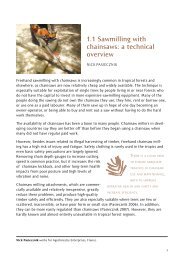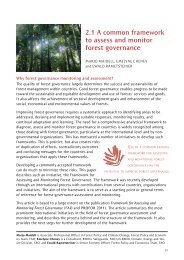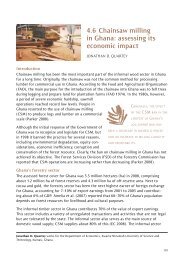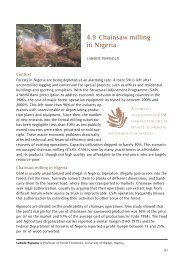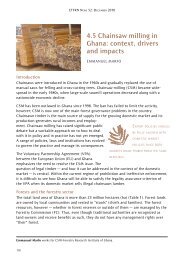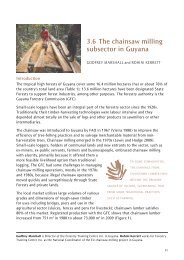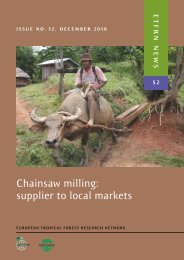Chainsaw milling: supplier to local markets - European Tropical ...
Chainsaw milling: supplier to local markets - European Tropical ...
Chainsaw milling: supplier to local markets - European Tropical ...
Create successful ePaper yourself
Turn your PDF publications into a flip-book with our unique Google optimized e-Paper software.
Figure 2. sawn<br />
timber exported from<br />
cameroon through the<br />
kousséry-Ndjamena<br />
bridge (m 3 /year)<br />
source: survey in 2005<br />
4.2 ThE chaiNsaw supply chaiN iN camERooN: ThE NoRThERN TRail<br />
Timber trade<br />
The north Cameroon demand for timber is not new and has been documented (bare<br />
1989). by the end of the 1980s, north Cameroon was a collection point for timber from<br />
bangui and batalimo in rCa, which then continued on <strong>to</strong> Chad, niger, nigeria and beyond.<br />
nowadays, most timber comes from the humid forests of East Cameroon, supplying north<br />
Cameroon as well as the even greater demand of other countries without forest resources.<br />
Timber, mostly from the forests bordering the sanaga river, travels through East<br />
Cameroon <strong>to</strong> Chad. a bridge over the logone river, which is the border between north<br />
Cameroon and Chad, connects kousséry and ndjamena (capital of Chad). From ndjamena,<br />
the timber is dispatched <strong>to</strong> the rest of Chad, and <strong>to</strong> other <strong>markets</strong> as far away as north<br />
nigeria, libya and even algeria (Figure 2). The annual volume crossing this border point<br />
has been assessed at 40,000 m 3 /year of sawn timber, equivalent <strong>to</strong> more than<br />
130,000 m 3 /year of roundwood (koffi 2005). This assessment<br />
is conservative; actual quantities could be higher.<br />
according <strong>to</strong> our interviews, the domestic and inter-african<br />
trade of sawn timber has existed for many years. before<br />
1998, it was not an informal trade and the wood was<br />
officially bought from several forest companies. after the<br />
1998 reform of the Cameroon forest sec<strong>to</strong>r, the licensing<br />
criteria changed, and since none of the forest companies that<br />
supplied the northern trail were able <strong>to</strong> meet the new<br />
conditions, they shut down. many informal chainsaw<br />
operations then developed <strong>to</strong> meet the demand. The demand<br />
for sawn timber in north Cameroon is limited (800 m 3 /year<br />
in ngaoundéré; 1,000 m 3 /year in Garoua; 1,500 m 3 /year in maroua); the real engine of the<br />
trade is the demand from other countries, including sudan, Egypt, niger and algeria.<br />
The timber supply is highly seasonal (Table 1), because the rainy season (from June <strong>to</strong><br />
oc<strong>to</strong>ber) complicates felling operations and transport.<br />
131



